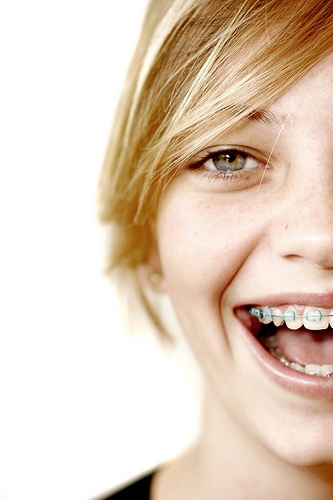August 18th, 2014

If you’ve been hiding your smile because you have crooked teeth or gaps between your teeth, it’s time to consider orthodontic treatment with Dr. Mark Guevarra. Preparing for treatment is an important part of getting the smile you want.
Basic exams
The first step of preparation is the examination. An oral exam and X-rays taken at our office are necessary to identify potential problems and ensure the right steps are taken to prepare for orthodontic treatment at Iowa Orthodontic Solutions.
Dr. Mark Guevarra will first examine your teeth and take X-rays to determine if it is necessary to extract any teeth or additional work is necessary before braces are possible. You will be prepared for the next step of treatment after your exam is complete and potential problems are identified.
Model for bite
The next step in preparing for orthodontic is taking a plaster model of the mouth. With the model, Dr. Mark Guevarra will be able to determine how the jaw is aligned so that appropriate adjustments can be made to the mouth and jaw with braces.
Depending on the situation, the model may be used to help evaluate your jaw and make decisions about appropriate treatment for your specific needs. Dr. Mark Guevarra can create a model of your mouth with the bite indentation that is taken during preparation.
Extracting teeth
If it is determined that a tooth extraction is necessary, then the final step of preparing for orthodontic treatment is the removal of teeth. Only Dr. Mark Guevarra can determine if it is necessary to remove any teeth before moving forward with the procedure to put on braces.
When your teeth are crooked, have a gap, or otherwise make you unhappy, orthodontic treatment at Iowa Orthodontic Solutions may be an appropriate solution. Although it may take time to prepare for the actual procedure, making the decision to seek treatment can provide the opportunity to show the world a beautiful smile.
For more information about orthodontic treatment and its benefits, or to schedule a consultation with Dr. Mark Guevarra, please give us a call at our convenient Iowa office!
August 11th, 2014

Everyone wants a naturally aligned and beautiful smile, and it is no secret that orthodontic braces from Iowa Orthodontic Solutions can help deliver one. However, there are greater benefits to wearing braces than just having straight teeth. You’ll gain many oral health benefits in addition to the cosmetic ones.
Tooth Decay and Gum Disease
Crooked or crowded teeth may overlap each other and create tight spaces in between. These can make it very difficult to brush and floss effectively, allowing bacteria and plaque to build up, and eventually leading to tooth decay and gum disease. With orthodontic treatment, your teeth will become properly aligned and spaced, which allows for more effective brushing.
Difficulties with Speech
Your teeth play an essential role in speech. When they are out of line or lean too far forward or backward, this can affect your speaking patterns, and possibly cause embarrassment and frustration. Braces can readjust the positioning of the teeth to allow for clearer, more professional speech.
Bone Erosion
Bone and gum tissues begin to erode when there are no teeth to support. This is also true for poorly aligned teeth that leave gaps and spaces or place too much pressure on the jawbone due to a bad bite. With braces, the bones and tissues are less likely to erode and can continue to support the teeth in their new alignment.
Digestion
Your teeth play an important role in digestion. Before food ever enters your stomach, it has been partially digested by the teeth. If teeth are severely out of line, however, they may not play their role in breaking down food as effectively as they should. With braces, your teeth will be straightened into optimal alignment for eating and chewing.
Dr. Mark Guevarra and staff will be happy to answer any of your questions about your orthodontic treatment. Visit us in Iowa today!
August 4th, 2014

Perhaps you feel your teeth are not perfectly straight, or you think your bite could be adjusted. It’s quite possible that braces and other orthodontic treatments might be the right choice for you. As orthodontic professionals, our team at Iowa Orthodontic Solutions works with your general dentist in order to determine the best options for your oral health and cosmetic appearance.
You might need braces if ...
- You lost your baby teeth relatively early in life. If your baby teeth fell out too early and your adult teeth did not come in for a while, this could have affected the way your adult teeth grew and developed.
- Your teeth look crowded or crooked. If you are embarrassed to smile because your teeth are not straight, it might be time to consider the cosmetic options available to you.
- Your jaw shifts or makes sounds. This can signify a developmental issue with your teeth and your jaw line, and orthodontic treatment may be able to help. Set up an appointment with Dr. Mark Guevarra if your jaw is recessed or protruding as well.
- You are constantly biting the sides of your cheek or hitting the roof of your mouth. This could indicate that your teeth are not properly aligned. Braces can address an underbite or an overbite.
- You have a difficult time chewing your food. This is not only an inconvenience, but it can also be detrimental for your health. Braces can help fix the alignment of your teeth.
- You have to breathe through your mouth on a regular basis. You may not attribute this to an issue with the development of your teeth or jaw, but orthodontic treatment might be able to help.
The ideal age for a child to be seen by an orthodontist is age seven. However, there are many orthodontic treatment options available to adults. It is becoming increasingly common for adults to wear braces and other orthodontic devices. We recommend that people who are interested in braces and other orthodontic treatment options set up a consultation appointment with Dr. Mark Guevarra today.
July 28th, 2014

Great question! Tooth movement is your body’s natural response to light pressure applied by braces over a period of time (usually two years). Braces work by using brackets that are glued onto your teeth; these brackets have small slots, and that is where Dr. Mark Guevarra and our team insert orthodontic wires. These wires are held in place by small elastic ties that fit around the brackets. As time passes during your treatment, these wires apply pressure on your teeth, which sets in motion the movement of your teeth into their desired positions. Each of your teeth has a different size and shape to them, as do the brackets. Each bracket is custom-made for the particular tooth on which it’s supposed to fit.
Not long ago, orthodontists had stainless steel wires and that was about it. Today, however, we have a number of different high-tech wires at our disposal to move your teeth faster and more comfortably.
When you first get your braces on, the first wire or two will typically be very flexible, but still strong enough to apply a constant force on your teeth. As your teeth straighten out over time, however, Dr. Mark Guevarra will use progressively thicker and firmer wires to help move your teeth in place for an ideal bite.
Every time you visit our office for an adjustment, we will swap out the wires in order to keep putting pressure on your teeth, which is why it’s so important for you to keep your adjustment visits during your treatment. Most adjustment appointments are scheduled four to eight weeks apart to give your teeth time to move.
As for rubber bands and elastics, most of our patients will need to wear elastics or rubber bands at some point during their treatments. These elastics typically go from one or more of the upper braces to one or more of the lower braces, and pull on your teeth to move them in the direction they need to move in order to achieve an optimal bite.
If you have any questions about wires, brackets, or elastics, or have any general questions about your treatment, please give us a call at our Iowa office.





 Website Powered by Sesame 24-7™
Website Powered by Sesame 24-7™